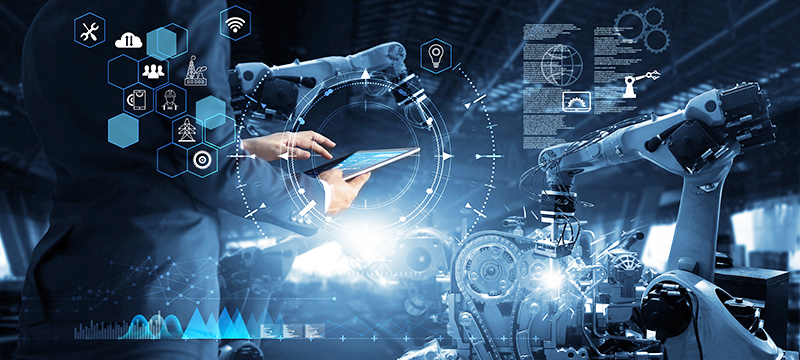Device Management and Data Analytics as Success Factors

The era of simple device communication is over. Today’s IIoT systems must go far beyond traditional device management and incorporate intelligent data analytics to remain competitive in the long term.
Communication between machines and devices has a long history, dating back to the last century. Simple machine-to-machine (M2M) communication once involved controlling production systems, such as conveyor belts and packaging machines, which sent signals to each other to ensure products were packaged correctly. However, with the development of technical capabilities and the simultaneous rise in expectations within the industrial Internet of Things (IIoT), device communication has also evolved. Gone are the days of basic device connectivity – today, comprehensive device management paired with innovative data analytics is required.
Companies relying on outdated M2M communication to improve efficiency and optimise business processes risk being overtaken by the competition.
From M2M to Full Integration
Across various industries, companies nowadays operate within a highly complex ecosystem of people, machines, and systems – all connected by highly digitised technology. Examples include smart factories and intelligent buildings. This interconnected mix generates an immense amount of data, which can only be effectively managed with advanced analytics and intelligent device management.
A key step in the evolution of IIoT systems was decentralised data processing. Early M2M systems enabled direct machine-to-machine communication, but only to a limited extent. Deeper analyses or device integration were not possible. Sensor data was sent to the cloud for management. However, with the explosion of data volumes, transferring this information to the cloud has become cost-prohibitive. Instead, local data preprocessing now occurs on mini-IIoT platforms (thick edge) or even directly on individual devices or gateways (thin edge). Only selected data is then sent to the cloud, where it is processed and relayed back to the machines. This distributed architecture not only improves efficiency but also reduces latency, allowing for faster decision-making at the edge.
Advanced Device Management: The Backbone of Modern IIoT Systems
Device management is the core of IIoT, as IIoT is fundamentally about connecting various devices to support business processes. Managing and operating these devices securely and efficiently is the starting point for a company’s intelligent, automated processes. Device management encompasses managing the fleet—handling firmware & software updates, configuration management, remote access, and addressing connectivity problems and errors.
Beyond these operational tasks, advanced device management provides holistic oversight throughout a device’s lifecycle—from installation to updates and decommissioning. A key advantage is reducing device downtime, as companies can detect and resolve connectivity issues or software errors early on, before they disrupt operations.
Many companies underestimate the value of transparency in ensuring smooth operational processes. This includes knowing how many machines are operational and functioning correctly. Once companies achieve this basic level of insight, they can tackle more complex analytical use cases, such as predictive maintenance. Cybersecurity is another critical factor, especially with the Cyber Security Act, which will take effect in 2025 and requires machine manufacturers in the European Union to report security vulnerabilities within 24 hours. Without a cloud-based device management solution that reflects the current status of firmware and software on devices, compliance with this law is nearly impossible. Remote, automated software and firmware updates, along with configuration changes, can help promptly close security gaps.
As companies grow, the scalability of their IIoT solutions becomes increasingly important. A modern IIoT platform helps securely connect a global fleet of devices and centrally manage device configurations.
Strategic Data Analytics: Key to Efficiency Gains
With the rising number of sensors in devices, the volume of data also grows exponentially. Processing and analysing this data is one of the most important tasks for IIoT platforms like Cumulocity. Different use cases can be categorised, with the understanding that pure data analytics doesn’t automatically translate into changes or interventions in operational processes. Rather, it provides insights that serve as a foundation for actions arising from data analysis.
A simple form of this is remote monitoring, where device utilization is tracked – how many hours per day does the construction site use the excavatort? More advanced use cases include smart field services, where sensors monitor the usage and condition of machines. This leads to targeted maintenance interventions, where service teams know exactly when a machine needs servicing and which parts are affected. The next level is performance management, where factors such as the quality, efficiency, and availability of machines—or even entire factories—are analysed. Key performance indicators like OEE (Overall Equipment Effectiveness) become important, allowing companies to identify and address bottlenecks, improving overall operational efficiency.
Conclusion: Device Management and Data Analytics Ensure Competitiveness
The transformation from M2M communication to fully integrated IIoT systems makes it clear that simple device connectivity is no longer enough. Companies that want to stay competitive must rely on advanced device management combined with IoT data management and analytics to meet the growing demands of a connected world. By adopting these technologies, businesses can enhance operational efficiency, reduce downtime, and unlock new opportunities for growth and innovation. Those that fail to embrace this transformation risk falling behind in a rapidly advancing market, while those that do will position themselves for long-term success in the era of smart, connected systems.
About the author: Dr. Jürgen Krämer is the Chief Product Officer at Cumulocity, with responsibility for the brand’s entire product and service portfolio, its vision and strategy to drive innovation and growth. He oversees the product management, product marketing, professional services and partner ecosystem teams. Jürgen holds a PhD with honours in Computer Science and has over 20 years of international professional experience, encompassing software development and general management.



